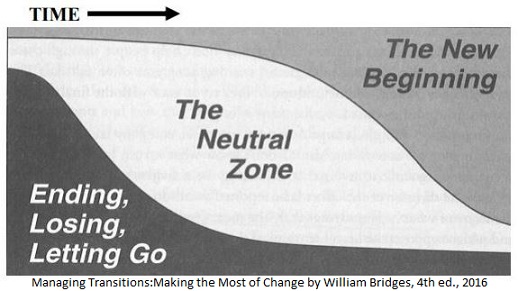Managing Transitions: Making the Most of Change
Posted on November 11, 2020
by Amy and Meg
Here’s the recorded Working Through Transitions presentation (it’s about 52 minutes of pure edutainment!), and go here for just the slides.
Here’s the Gist:
Even in the best of times change is difficult, and libraries must continually change to stay relevant. The Toledo Lucas County Public Library used key points from William Bridges’ Managing Transitions: Making the Most of Change (4th edition, 2016) as a means by which to lead the library system during a year of massive change in 2018-2019.
In the presentation, Meg and Amy:
- Engage in a lively discussion peppered with examples from a complex Main Library renovation, complete reorganization of the administrative structure, and throw in a sprinkling of reflections on COVID-induced change for good measure.
- Demonstrate how to work through nitty-gritty details like front-line staff who feel blindsided and uniformed about institutional change and administrators who become frustrated by unexpected pushback and perceived obstinance to new ideas.
- Share Bridges’ idea that transition is a 3-phase psychological process people go through when confronted with change and how prioritizing the transition rather than the change itself has some remarkable results.
Key Concepts: Bridges clearly differentiates the terms CHANGE and TRANSITION.
Change is situational, based on what one does: the move to a new site, the retirement of the founder, the reorganization of the roles on the team.
Transition is psychological, based on how one feels: it is a three-phase process that people go through as they internalize and come to terms with the details of the new situation that the change brings about. Think of getting your first job, moving into your first home, or coming home with your first child. The actual change probably happened quickly, but the psychological transition happened much more slowly. Instead of becoming a new person as fast as you changed outwardly, you may have found yourself struggling for a time in a state that was neither the old nor the new.
Here is how Bridges pictures that transition process:

Quick summary of the three phases:
- Ending— Give people adequate time to say “goodbye” and mourn the way things used to be. There will be a sense of loss and signs of grieving. This is natural and should be expected.
- Neutral Zone – During this awkward in-between time, the old is gone but the new isn’t fully developed. People understand that there is no going back, the change is actually happening – but they haven’t yet found their clear way forward. Look for deep emotions and strong pushbacks.
- Beginning—People emerge from the chaos and confusion of the first two stages with a new identity, new energy and a renewed sense of purpose. Beginnings take place only when people are ready to make the emotional commitment to do things the new way and see themselves as new people. Because transition is a process by which people unplug from an old world and plug into a new world, we can say that transition starts with an ending and finishes with a beginning.
In Toledo, the organizational culture we’re building is based on our understanding of Bridges’ concepts and tools, especially:
- Commitment to regular and transparent communication
- Reaffirming our institutional values in being welcoming, innovative, objective, accountable and collaborative in all we do
- Sharing the reassurance that amid continuous change, “it’s going to be okay,” and will be BETTER if everyone is involved in the transition
Change + Human Beings = Transition. Whatever currently exists is going to change, and most importantly: you can manage it!
Managing Transitions: Making the Most of Change (4th edition)
By William Bridges with Susan Bridges
Organizational transitions affect people; it is always people, rather than a company, who have to embrace a new situation and carry out the corresponding change. As veteran business consultant William Bridges explains, transition is successful when employees have a purpose, a plan and a part to play. Directed at managers on all rungs of the corporate ladder, but also helpful for employees at any level, this expanded edition of the classic bestseller provides practical, step-by-step strategies for minimizing disruptions and navigating uncertain times.
Transitions: Making Sense of Life’s Changes
By William Bridges
Book Bridges takes readers step-by-step through the three perilous stages of any transition, explaining how each stage can be understood and embraced. The book offers an elegant, simple, yet profoundly insightful roadmap to navigate change and move into a hopeful future.
Did you like this blog post? Keep up to date with all of our posts by subscribing to the Library’s newsletters!
Keep your reading list updated with our book lists. Our staff love to read and they’ll give you the scoop on new tv-series inspired titles, hobbies, educational resources, pop culture, current events, and more!
Looking for more great titles? Get personalized recommendations from our librarians with this simple form.

